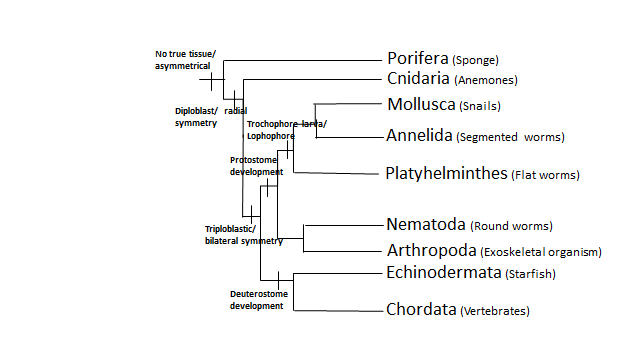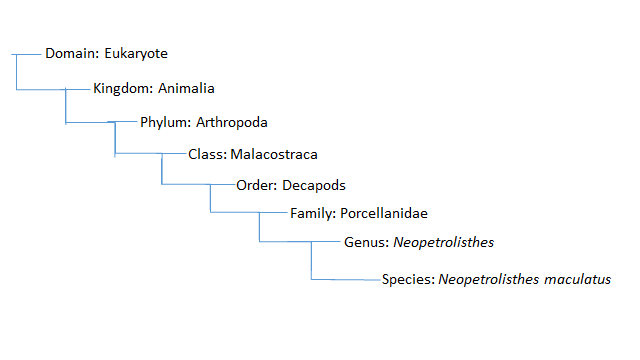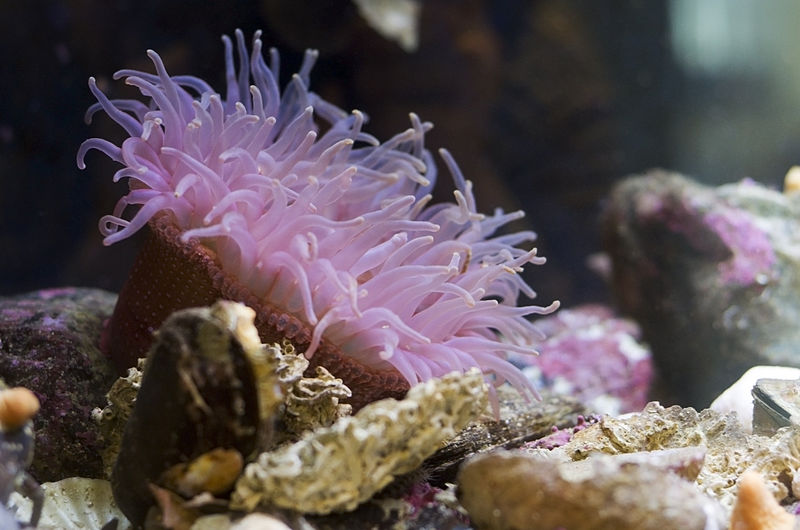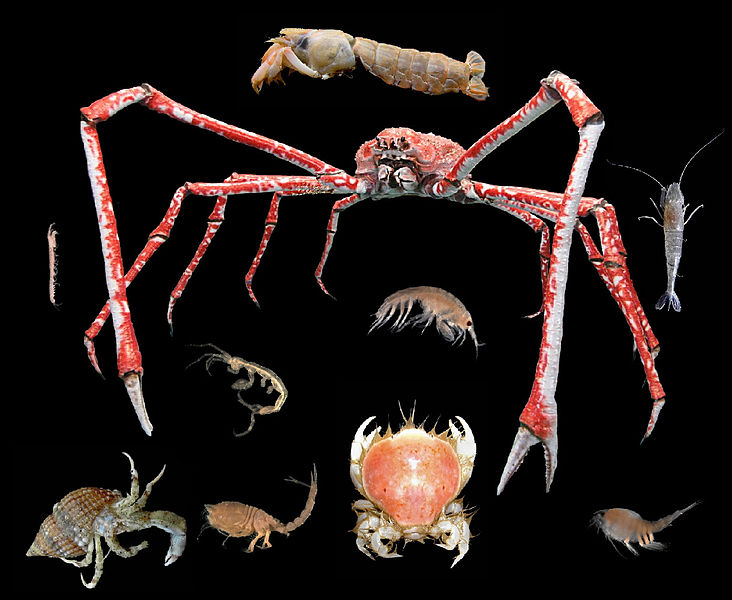Classification of N. maculatus
Domain .......................................... Eukarya
Kingdom ....................................... Animalia
Phylum .................................... Arthropoda
Class ...................................... Malacostraca
Order ........................................... Decapoda
Family ................................... Porcellanidae
Genus ................................ Neopetrolisthes
Species ........... Neopetrolisthes maculatus
Before getting any further, it would be a good idea to establish what the name Neopetolisthes maculatus means. Maculatus comes from the Latin root macula, meaning "spot, stain" (Online Etymology Dictionary, 2001).

Figure 1. The image above is showing a blown up portion of the animal
phyla I studied in Organismal Biology 203. It also shows the major
synapomorphic (a
characteristic presented in more than one related organism)
structures. The Spotted Porcelain Crab would fall under the
Arthropoda category. Take a look at the next diagram to see how
exactly this organism was named. This
graph was generated with the help of Alyxandra Walters. To view her
web page and learn about her organism,
click here.

Figure 2. The image showing the careful classification layout of the Neopetrolisthes maculatus. Each and every extension in the diagram has unique qualities that further classify the organism. Read below to see what I mean by this. Figure 2 was created by the author of this web page, Britney Kocken.
Domain - Eukarya
An organism that is defined as
being an eukaryote has a nucleus in the cells as well as other
structures within the closed membranes.
Kingdom - Animalia
Animals are multicellular.
Their body plan eventually becomes fixed as they develop, although
some undergo a process of metamorphosis (a process of transformation
from an immature stage to an adult stage) later on in their lives.
Most animals are motile, meaning they can move spontaneously and
independently. All animals must ingest other organisms or their
products for sustenance. Most known animal phyla appeared in the
fossil record as marine species during the Cambrian explosion, about
542 million years ago. Animals are divided into sub- groups,
including birds, mammals, amphibians, reptiles, fish and insects
(The Global Biodiversity Information Facility, 2013).
Phylum - Arthropoda
An arthropoda is an
invertebrate (animal lacking a backbone) animal having an
exoskeleton (external skeleton), a segmented body, and jointed
appendages. Arthropods are members of the phylum Arthropoda which includes the insects, arachnids,
and crustaceans. Arthropods are characterized by their jointed limbs and cuticles
(tough but flexible outer covering), which are mainly made of chitin.
The cuticles
of crustaceans are also bio mineralized with calcium carbonate. The
rigid cuticle inhibits growth, so arthropods replace it periodically
by molting (The Global Biodiversity Information Facility, 2013).
Class - Malacostraca
Malacostraca is the largest of
the six classes of crustaceans, containing over 25,000 extant
species, divided among 16 orders. The members display a greater
diversity of body forms than any other class of animals, and include
crabs, lobsters, shrimp, krill, woodlice, scuds (Amphipoda), mantis
shrimp and many other less familiar animals. They are abundant in
all marine environments and have also colonized freshwater and
terrestrial habitats. They are united by a common comparison of 20
body segments, divided into a head, thorax, and abdomen (The Global
Biodiversity Information Facility, 2013).
Order - Decapods
The decapods or Decapoda
(literally 'ten-footed") are an order of crustaceans within the
class Malacostraca, including many familiar groups, such as
crayfish, crabs, lobsters, prawns and shrimp. Most decapods are
scavengers (The Global Biodiversity Information Facility, 2013).
Family - Porcellanidae
Porcelain crabs are decapod
crustaceans in the widespread family Porcellanidae, which
superficially resemble true crabs. They have flattened bodies as an adaptation for living in rock
crevices. They are delicate, readily losing limbs when attacked, and
use their large claws for maintaining territories (The Global
Biodiversity Information Facility, 2013).
Genus -
Neopetrolisthes
Neopetrolisthes is a genus
of porcelain crabs that live on sea anemones, and contain the
following three species: Neopetrolisthes maculatus,
Neopetrolisthes Miyake, and Neopetrolisthes allocates (The
Global Biodiversity Information Facility, 2013).
Species -
Neopetrolisthes maculatus
Neopetrolisthes maculatus is a
species of porcelain crab form the Indo-Pacific region. It is
a small, colorful crustacean with a porcelain-like shell. This
porcelain crab is usually found within the stinging tentacles of a
number of sea anemone species (The Global Biodiversity Information Facility, 2013).

